

As we move from August into September the apple picking season really takes off!
While early apples have been harvested since late July, September marks the start of harvesting for 'long term' storage: apples grown for marketing in March/April 2019 require picking before the fruit loses the conditions necessary for long term storage.
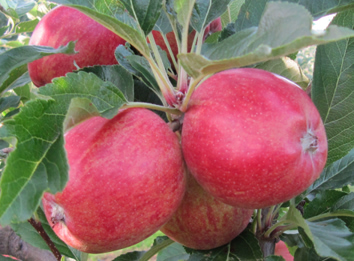 Since the mid 1990's growers of Gala apples have gathered in early September for an orchard walk organised by the Gala Club. This year the event will be held at AC Goatham's Flanders Farm, Ratcliffe Highway, Rochester ME3 8QE on Wednesday 5th September - Starting at 4.30pm
Since the mid 1990's growers of Gala apples have gathered in early September for an orchard walk organised by the Gala Club. This year the event will be held at AC Goatham's Flanders Farm, Ratcliffe Highway, Rochester ME3 8QE on Wednesday 5th September - Starting at 4.30pm
The Gala Club Meeting starts at The Arthur Goatham building: followed by a walk around Turkey Hall Farm a 175 acre farm planted over the last three years with Gala & Cox apples and Conference pears.
Returning to the harvest criteria for long term apple storage, the indications suggest Cox picking should be 'under way' next week, while Gala looks like being ready for harvest W/C 10th September.
Red colour is looking good this year, triggered by the cooler nights recently: red colour depends on the day night temperature contrast, so a cold night followed by a warm day is the ideal scenario for developing red colour.
"That having been said" - growers are turning to redder clones of varieties which increase the red colour naturally and allow more fruit to be harvested in the 'first pick' - clones adopted by countries/regions where nights stay warm (South of France) were often considered too red for the UK Gala market. Changes have made the high colour clones like Galaxie Gala very popular.
Below: left; Galaxie Gala and right; Royal Beaut Gala
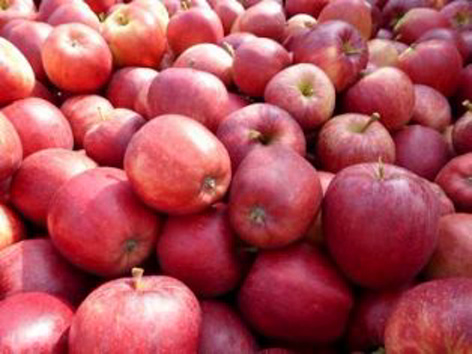
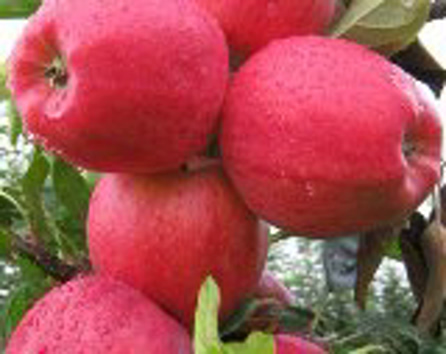
Below: comment and advice to Gala growers from a technical colleague............
"In all cases last year, the fruit with the highest brix levels was the early picked fruit and some of the fruit left on the tree for a supposed increase in brix actually went down in store! "
"Therefore: Regarding brix levels, once starch levels are 90% or below DO NOT DELAY PICKING IN THE HOPE YOUR BRIX LEVELS WILL RISE!!
Below: Gala starch recorded at 99% on 29th August 2018
 Gala Long term picking target:- Starch >80%
Gala Long term picking target:- Starch >80%
Gala holds it's starch level high (picture left is at 99% starch level) but once the level starts to drop, it will drop at 4% per day (unlike Cox which drops at circa 2% per day)
Years of storage experience (UK and New Zealand) have shown Gala stores better and delivers better eating fruit if it is harvested at a higher starch than other dessert varieties. Initial research in New Zealand found that the brix level 'rises in store' as starch turns to sugar in store. This changed the storage protocol as Gala can have low levels of brix at harvest (below customer specification) but adjusts upwards in store!
Interestingly: and this is factual; Gala is not naturally high in sugar, it is the lack of acidity which attracts many of the younger consumers. It is also one of the best apples for attracting children in the Fruit for Schools programme into eating apples, not due to the perceived sugars, but due to the 'forgiving texture' and by that I mean the small children's teeth cope with the texture.
Below: Cox starch recorded at 78% on 29th August 2018
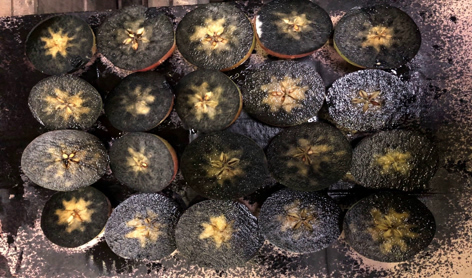 Cox Long term picking target:- Firmness >8.6kg, Starch >70%, Brix >11%
Cox Long term picking target:- Firmness >8.6kg, Starch >70%, Brix >11%
Indications are: Cox picking for long term storage (March/April) should begin on most sites w/c 3rd September. Generally, pressures and brix are very good this year being at least 1kg firmer and 10-15% higher starch than at the same stage last year, which bodes very well for eating quality.
There are: However, some orchards (in West Kent) are already below the recommended long term storage harvesting threshold of 8.6kg and these orchards should be earmarked for short term storage.
Colour is changing rapidly due to some recent cold nights!
Ensuring the harvest criteria is correct for the planned storage period is vital, but it is also very important that growers remember to take store samples of all orchards (representing 30 bins or more) in a store. Samples should contain 20 apples and be an accurate representation of the fruit within each store. This is very often the only means available for assessing the size, colour, storage potential, profiles of the fruit and allows the marketing team an opportunity to assess the marketing period for the fruit before it is 'locked away' in store for several months.
It is also important growers ensure 'store monitoring samples' are labelled with farm name, orchard name, picking date and store name. This is of vital importance for all samples. During the storage season samples will be removed monthly and assessed for fruit firmness, brix (sugar) and freedom from internal disorders.
Below: Conference starch recorded at 60% on 30th August 2018
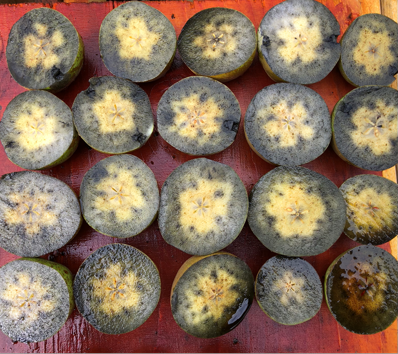 Conference Pear Long term picking target:- Streif Index 1.0-0.7, Firmness >5.5kg, Starch >50%, Brix >11%
Conference Pear Long term picking target:- Streif Index 1.0-0.7, Firmness >5.5kg, Starch >50%, Brix >11%
While we use minimum starch, fruit firmness and brix for dessert apples, pears are best gauged by the Streif index.
The Streif index is accepted as the best guide to maturity and gauging picking date. The range for using Streif index for picking pears. The index should be between 1.5 for long term storage and 0.7 for short term.
Bramley picking for long term storage should now be underway on all sites and even where it is destined for shorter term storage, picking should be imminent.
While this week's Journal concentrated on 'long term storage' requirements, consumers should look out for UK early/mid season varieties: Zari, Estivale, Red Windsor and Worcester Pearmain.
Until next week
Take care
The English Apple Man